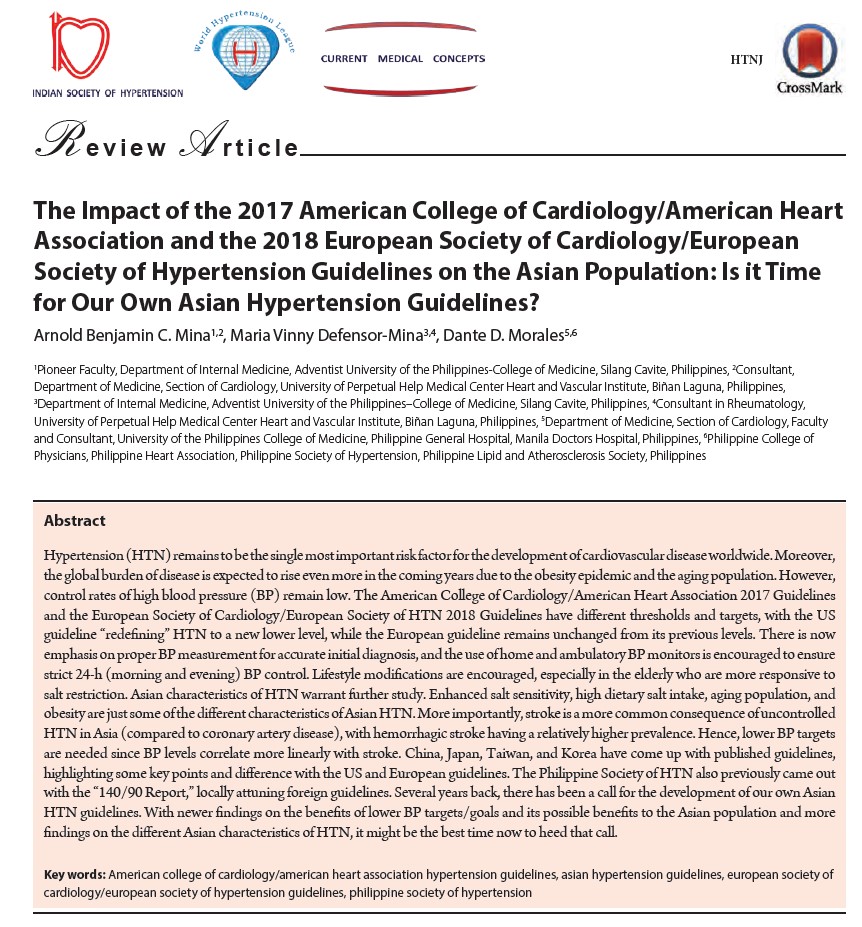The Impact of the 2017 American College of Cardiology/American Heart Association and the 2018 European Society of Cardiology/European Society of Hypertension Guidelines on the Asian Population: Is it Time for Our Own Asian Hypertension Guidelines?
Main Article Content
Abstract
Hypertension (HTN) remains to be the single most important risk factor for the development of cardiovascular disease worldwide. Moreover, the global burden of disease is expected to rise even more in the coming years due to the obesity epidemic and the aging population. However, control rates of high blood pressure (BP) remain low. The American College of Cardiology/American Heart Association 2017 Guidelines and the European Society of Cardiology/European Society of HTN 2018 Guidelines have different thresholds and targets, with the US guideline “redefining” HTN to a new lower level, while the European guideline remains unchanged from its previous levels. There is now emphasis on proper BP measurement for accurate initial diagnosis, and the use of home and ambulatory BP monitors is encouraged to ensure strict 24-h (morning and evening) BP control. Lifestyle modifications are encouraged, especially in the elderly who are more responsive to salt restriction. Asian characteristics of HTN warrant further study. Enhanced salt sensitivity, high dietary salt intake, aging population, and obesity are just some of the different characteristics of Asian HTN. More importantly, stroke is a more common consequence of uncontrolled HTN in Asia (compared to coronary artery disease), with hemorrhagic stroke having a relatively higher prevalence. Hence, lower BP targets are needed since BP levels correlate more linearly with stroke. China, Japan, Taiwan, and Korea have come up with published guidelines, highlighting some key points and difference with the US and European guidelines. The Philippine Society of HTN also previously came out with the “140/90 Report,” locally attuning foreign guidelines. Several years back, there has been a call for the development of our own Asian HTN guidelines. With newer findings on the benefits of lower BP targets/goals and its possible benefits to the Asian population and more findings on the different Asian characteristics of HTN, it might be the best time now to heed that call.
Metrics
Article Details

This work is licensed under a Creative Commons Attribution-NonCommercial-ShareAlike 4.0 International License.
All open access articles published in the journal are distributed under the terms of the CC-BY-NC-SA 4.0 license (Creative Commons Attribution-Non-commercial 4.0 International License) which permits unrestricted use, distribution, and reproduction in any medium, for non-commercial purposes, provided the original work is properly cited. Under Creative Commons, authors retain copyright in their articles.
References
In: Eugene B, editor. Heart Disease: A Textbook of
Cardiovascular Medicine. 5th ed. Philadelphia, PA: W B Saunders
Co.; 1997. p. 807.
In: Robert OB, editor. Heart Disease: A Textbook of
Cardiovascular Medicine. 9th ed. Philadelphia, PA: Elsevier;
p. 935.
Cheung BM, Cheung TT. Challenges in the management
of hypertension in Asia. Eur Heart J Suppl 2012;14 Suppl A
:A31-8.
Aram VC. The hypertension paradox: More uncontrolled disease
despite improved therapy. N Engl J Med 2009;361:873-89.
Huebschmann AG, Mizrahi T, Soenksen A, Beaty BL,
Denberg TD. Reducing clinical inertia in hypertension
treatment: A pragmatic randomized controlled trial. J Clin
Hypertens (Greenwich) 2012;14:322-9.
O’Connor PJ, Sperl-Hillen JM, Johnson PE, Rush WA, Biltz G.
Clinical inertia and outpatient medical errors. In: Henriksen K,
Battles JB, Marks ES, Lewin DI, editors. Advances in Patient
Safety: From Research to Implementation. Vol. 2. Concepts and
Methodology Rockville, MD: Agency for Healthcare Research
and Quality (US); 2005. p. 293-308.
Phillips LS, Twombly JG. It’s time to overcome clinical inertia.
Ann Intern Med 2008;148:783-5.
Chobanian AV, Bakris GL, Black HR, Cushman WC, Green LA,
Izzo JL Jr., et al. Seventh report of the joint national committee
on prevention, detection, evaluation, and treatment of high
blood pressure. Hypertension 2003;42:1206-52.
Poulter NR, Castillo R, Charchar FJ, Schlaich MP,
Schutte AE, Tomaszewski M, et al. Are the american heart
association/ American college of cardiology high blood pressure
guidelines fit for global purpose? Thoughts from the international
society of hypertension. Hypertension 2018;72:260-2.
Kim HC, Jeon YW, Heo ST. Global impact of the 2017 ACC/ AHA
hypertension guidelines: A perspective from Korea. Circulation
;138:2312-4.
Ji-Guang W. Global impact of the 2017 ACC/AHA hypertension guidelines: A perspective from China. Circulation 2018;137:546-8.
Kario K. Global impact of 2017 american heart
association/ American college of cardiology hypertension
guidelines: A Perspective from japan. Circulation 2018;137:543- 5.
Tadic M, Cuspidi C. Does the change of hypertension guidelines
actually affect our reality? Ann Transl Med 2018;6:373.
Melvin Rubenfire, 2018 ESC/ESH Guidelines for Management
of Arterial Hypertension ACC; 2018.
Todd Neale, New European Hypertension Guidelines Not in
Harmony with US Guidelines, Jan 11, 2018.
American Heart Association News; 2018.
Gupta AK. Racial differences in response to antihypertensive
therapy: Does one size fits all? Int J Prev Med 2010;1:217-9.
Park JB. Asian guidelines on hypertension. Pulse (Basel)
;3:12-3.
Castillo R. Peers and Countless Patients Thank Dr. Ramon
Abarquez Jr., 89, Medical Files; 2018.
Data on File, Philippine Society of Hypertension. Available
from: http://www.philippinesocietyofhypertension.org.ph/
about.html. [Last accessed on 2019 May 10].
Wang JG. Chinese hypertension guidelines. Pulse (Basel)
;3:14-20.
Lee HY, Park JB. The korean society of hypertension guidelines
for the management of hypertension in 2013: Its essentials and
key points. Pulse (Basel) 2015;3:21-8.
Kario K. Key points of the japanese society of hypertension
guidelines for the management of hypertension in 2014. Pulse
(Basel) 2015;3:35-47.
Chiang CE, Wang TD, Lin TH, Yeh HI, Liu PY, Cheng HM, et al.
The 2017 focused update of the guidelines of the taiwan society
of cardiology (TSOC) and the taiwan hypertension society
(THS) for the management of hypertension. Acta Cardiol Sin
;33:213-25.
Kario K, Chen CH, Park S, Park CG, Hoshide S, Cheng HM, et al.
Consensus document on improving hypertension management
in asian patients, taking into account asian characteristics.
Hypertension 2018;71:375-82.
